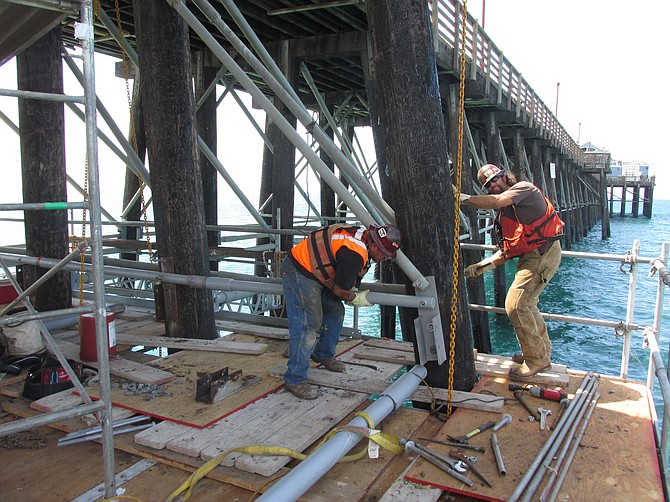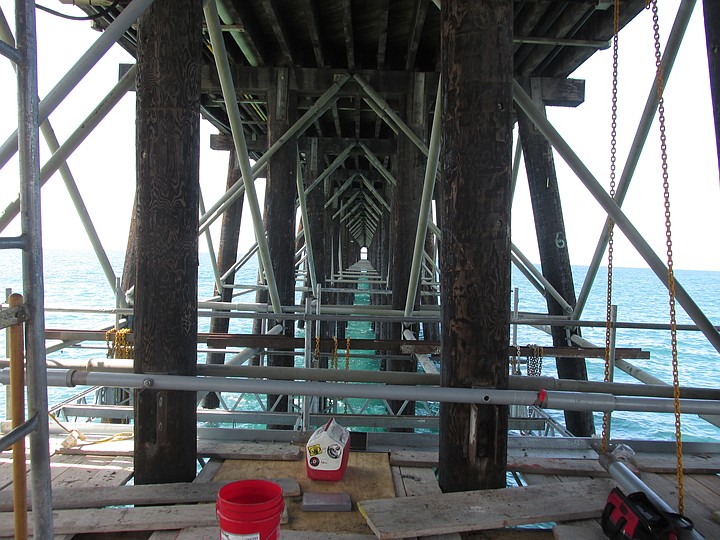 Facebook
Facebook
 X
X
 Instagram
Instagram
 TikTok
TikTok
 Youtube
Youtube

Perhaps in preparation for this year’s predicted El Niño weather pattern and its accompanying big waves and high tides, the Oceanside Pier is getting some extra support.
Construction crews will be under the pier for the next two weeks replacing some of the rusted-out, dangling metal-pipe crossbeams; the beams strengthen the pier’s wood pilings by tying them together.
Jeremy Albert, the foreman for Ballard Marine Construction, says his four-man crew is grateful to be working above water. Normally they’re underwater, as not only construction workers but also commercial divers. Prior to the project, his crew was in the shop for more than a month fabricating the heavy poles. “They are double-walled, a half-inch thick, and zinc-coated to prevent rusting,” said Albert.

A specialized scaffolding company, Safeway Services, built the 95´x 35´ construction platform under the pier, high enough to avoid high waves, yet heavy enough to support welding equipment. The scaffolding hangs by large chains from the 12˝x 12˝ wood beams on top of the pier. The crew wears hardhats and flotation devices should they fall in the water.
The city’s director of pier maintenance, Joel Menard, says the current phase will cost $200,000 — each of the 67 replacement pipe beams costs $2600. The project has been going on for five years, as money has become available. “We’re the fourth contractor,” says Albert.

“We’re only doing bent 56 through 60,” said Albert. Bent? “It means a row of pilings,” said Albert. And because his firm just opened an office in San Diego, they will bid on the future phases. (Ballard Marine is based in Seattle and has offices along both coasts and Lake Michigan; they also do marine projects around the world.)
I asked Albert if he had to build a pier of this size from scratch, would he use concrete or wood?
“Definitely wood. The rebar in concrete eventually rusts out. This pier should last another 75 years. It’s designed to sway in earthquakes and tsunamis,” he said. (Old trestle-style railroad bridges, some with wood beams over 100 years old, are still in use along Amtrak’s line in San Diego County.)
Once the longest pier on the West Coast, Oceanside Pier lost over half its length — 600 feet of it — in a large storm (before the El Niño term was used) in 1978. The pier was completely rebuilt in 1987, but not to its original length; it now extends to 1942 feet.
Footnote: California’s public ocean piers are the only places where one may fish without a fishing license — a rationale based on the right to hunt and gather food for your family. While most public piers are open 24 hours a day, some fish species and size are regulated by the Department of Fish and Wildlife.
Prior to the 1963 opening of the Oceanside Harbor, sportfishing boats would anchor offshore overnight, west of the pier. Fishermen, including this writer’s dad, would board the boats by climbing off the pier, down a ladder, crossing pilings on a 12-inch-wide platform, and then climb down a rope ladder, with a pole and tackle box, into the bobbing boat.


Perhaps in preparation for this year’s predicted El Niño weather pattern and its accompanying big waves and high tides, the Oceanside Pier is getting some extra support.
Construction crews will be under the pier for the next two weeks replacing some of the rusted-out, dangling metal-pipe crossbeams; the beams strengthen the pier’s wood pilings by tying them together.
Jeremy Albert, the foreman for Ballard Marine Construction, says his four-man crew is grateful to be working above water. Normally they’re underwater, as not only construction workers but also commercial divers. Prior to the project, his crew was in the shop for more than a month fabricating the heavy poles. “They are double-walled, a half-inch thick, and zinc-coated to prevent rusting,” said Albert.

A specialized scaffolding company, Safeway Services, built the 95´x 35´ construction platform under the pier, high enough to avoid high waves, yet heavy enough to support welding equipment. The scaffolding hangs by large chains from the 12˝x 12˝ wood beams on top of the pier. The crew wears hardhats and flotation devices should they fall in the water.
The city’s director of pier maintenance, Joel Menard, says the current phase will cost $200,000 — each of the 67 replacement pipe beams costs $2600. The project has been going on for five years, as money has become available. “We’re the fourth contractor,” says Albert.

“We’re only doing bent 56 through 60,” said Albert. Bent? “It means a row of pilings,” said Albert. And because his firm just opened an office in San Diego, they will bid on the future phases. (Ballard Marine is based in Seattle and has offices along both coasts and Lake Michigan; they also do marine projects around the world.)
I asked Albert if he had to build a pier of this size from scratch, would he use concrete or wood?
“Definitely wood. The rebar in concrete eventually rusts out. This pier should last another 75 years. It’s designed to sway in earthquakes and tsunamis,” he said. (Old trestle-style railroad bridges, some with wood beams over 100 years old, are still in use along Amtrak’s line in San Diego County.)
Once the longest pier on the West Coast, Oceanside Pier lost over half its length — 600 feet of it — in a large storm (before the El Niño term was used) in 1978. The pier was completely rebuilt in 1987, but not to its original length; it now extends to 1942 feet.
Footnote: California’s public ocean piers are the only places where one may fish without a fishing license — a rationale based on the right to hunt and gather food for your family. While most public piers are open 24 hours a day, some fish species and size are regulated by the Department of Fish and Wildlife.
Prior to the 1963 opening of the Oceanside Harbor, sportfishing boats would anchor offshore overnight, west of the pier. Fishermen, including this writer’s dad, would board the boats by climbing off the pier, down a ladder, crossing pilings on a 12-inch-wide platform, and then climb down a rope ladder, with a pole and tackle box, into the bobbing boat.
Comments